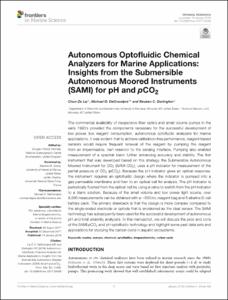| dc.contributor.author | Lai, Chun-Ze | |
| dc.contributor.author | DeGrandpre, Michael D. | |
| dc.contributor.author | Darlington, Reuben C. | |
| dc.date.accessioned | 2021-10-29T15:33:12Z | |
| dc.date.available | 2021-10-29T15:33:12Z | |
| dc.date.issued | 2018 | |
| dc.identifier.citation | Lai, C-Z, DeGrandpre, MD and
Darlington, RC (2018) Autonomous
Optofluidic Chemical Analyzers for
Marine Applications: Insights from the
Submersible Autonomous Moored
Instruments (SAMI) for pH and pCO2.
Frontiers in Marine Science, 4:438, 11pp.
DOI: https://doi.org/10.3389/fmars.2017.00438 | en_US |
| dc.identifier.uri | https://repository.oceanbestpractices.org/handle/11329/1765 | |
| dc.description.abstract | The commercial availability of inexpensive fiber optics and small volume pumps in the
early 1990’s provided the components necessary for the successful development of
low power, low reagent consumption, autonomous optofluidic analyzers for marine
applications. It was evident that to achieve calibration-free performance, reagent-based
sensors would require frequent renewal of the reagent by pumping the reagent
from an impermeable, inert reservoir to the sensing interface. Pumping also enabled
measurement of a spectral blank further enhancing accuracy and stability. The first
instrument that was developed based on this strategy, the Submersible Autonomous
Moored Instrument for CO2 (SAMI-CO2), uses a pH indicator for measurement of the
partial pressure of CO2 (pCO2). Because the pH indicator gives an optical response,
the instrument requires an optofluidic design where the indicator is pumped into a
gas permeable membrane and then to an optical cell for analysis. The pH indicator is
periodically flushed from the optical cell by using a valve to switch from the pH indicator
to a blank solution. Because of the small volume and low power light source, over
8,500 measurements can be obtained with a ∼500mL reagent bag and 8 alkaline D-cell
battery pack. The primary drawback is that the design is more complex compared to
the single-ended electrode or optode that is envisioned as the ideal sensor. The SAMI
technology has subsequently been used for the successful development of autonomous
pH and total alkalinity analyzers. In this manuscript, we will discuss the pros and cons
of the SAMI pCO2 and pH optofluidic technology and highlight some past data sets and
applications for studying the carbon cycle in aquatic ecosystems. | en_US |
| dc.language.iso | en | en_US |
| dc.rights | Attribution 4.0 International | * |
| dc.rights.uri | http://creativecommons.org/licenses/by/4.0/ | * |
| dc.subject.other | Optofluidics | en_US |
| dc.subject.other | Carbon cycle | en_US |
| dc.title | Autonomous Optofluidic Chemical Analyzers for Marine Applications: Insights from the Submersible Autonomous Moored Instruments (SAMI) for pH and pCO2. | en_US |
| dc.type | Journal Contribution | en_US |
| dc.description.refereed | Refereed | en_US |
| dc.format.pagerange | 11pp. | en_US |
| dc.identifier.doi | https://doi.org/10.3389/fmars.2017.00438 | |
| dc.subject.parameterDiscipline | Chemical oceanography | en_US |
| dc.subject.instrumentType | pH sensors | en_US |
| dc.subject.dmProcesses | Data acquisition | en_US |
| dc.bibliographicCitation.title | Frontiers in Marine Science | en_US |
| dc.bibliographicCitation.volume | 4 | en_US |
| dc.bibliographicCitation.issue | Article 438 | en_US |
| dc.description.sdg | 14.a | en_US |
| dc.description.eov | N/A | en_US |
| dc.description.methodologyType | Method | en_US |
| dc.description.methodologyType | Reports with methodological relevance | en_US |
| obps.contact.contactname | Michael D. DeGrandpre | |
| obps.contact.contactemail | michael.degrandpre@umontana.edu | |
| obps.resourceurl.publisher | https://www.frontiersin.org/articles/10.3389/fmars.2017.00438/full | |
 Repository of community practices in Ocean Research, Applications and Data/Information Management
Repository of community practices in Ocean Research, Applications and Data/Information Management

